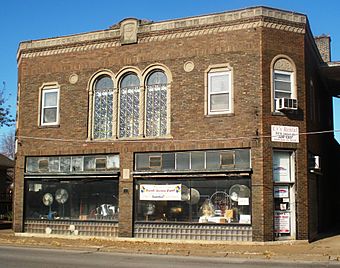Finley Guy Building facts for kids
Quick facts for kids |
|
|
Finley Guy Building
|
|
 |
|
| Location | 310 E. Locust St. Davenport, Iowa |
|---|---|
| Area | less than one acre |
| Architectural style | Mission/Spanish Revival |
| MPS | Davenport MRA |
| NRHP reference No. | 84001426 |
| Added to NRHP | July 27, 1984 |
The Finley Guy Building is a special old building in downtown Davenport, Iowa, United States. It was built in a unique style called Spanish Colonial Revival architecture. This building is so important that it was added to the National Register of Historic Places in 1984. This list helps protect buildings that are important to history.
Contents
Building History: What Was It For?
A man named Finley Guy had this building constructed in 1928. He wanted it to be the home for his own drug store. Another business, Lorenzen Grocery and Meat Market, also had a space there.
Finley Guy himself lived in an apartment on the second floor. Over the years, the building has been used for different shops, including a rental store for a long time.
Architecture: A Unique Look
The Finley Guy Building stands out because of its Spanish Colonial Revival architecture. This building style was not very common in Davenport. When it was used, it was usually for homes, not for businesses.
Cool Building Materials
The building has bricks that are very textured and have many colors. These are called polychrome bricks. It also has metal windows that open outwards, known as casement windows.
These types of bricks and windows were popular in Davenport in the late 1920s and 1930s. However, they were usually found on buildings designed in styles like Tudor Revival or Cotswold Cottage.
Special Decorations
The Finley Guy Building also features cool decorations made from molded concrete. You can see spiral-shaped columns, called colonnettes, framing the windows on the second floor.
Tiles with different patterns decorate the top edge of the roof, called the parapet. The concrete frames around the windows have a swirly, spiral pattern.
There is also a concrete sign between the main shop windows. It shows a symbol called a caduceus. This symbol has two snakes wrapped around a winged staff. It was often used to represent medicine, showing that the building was originally a drug store.



